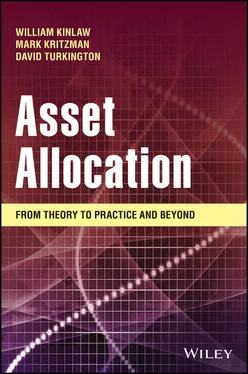6 Chapter 7TABLE 7.1 Country Expected Returns, Standard Deviations, and CorrelationsTABLE 7.2 Misestimated Country Expected ReturnsTABLE 7.3 Distortion in Optimal Country WeightsTABLE 7.4 Exposure to Loss for Correct and Incorrect Country WeightsTABLE 7.5 Asset Class Expected Returns, Standard Deviations, and CorrelationsTABLE 7.6 Misestimated Asset Class Expected ReturnsTABLE 7.7 Distortion in Optimal Asset Class WeightsTABLE 7.8 Exposure to Loss for Correct and Incorrect Asset Class WeightsTABLE 7.9 Sensitivity of Weights to Changes in Expected ReturnTABLE 7.10 Sensitivity of Portfolio Standard Deviation to Changes in Expected...
7 Chapter 8TABLE 8.1 Principal ComponentsTABLE 8.2 Instability of Industry, Size, Value, and Momentum Portfolios
8 Chapter 10TABLE 10.1 Characteristics of realized three-year volatilities
9 Chapter 11TABLE 11.1 Expected and Actual Volatility of Private Equity (December 1996–Se...
10 Chapter 12TABLE 12.1 Skewness over Increasing Return IntervalsTABLE 12.2 Excess Kurtosis over Increasing Return IntervalsTABLE 12.3 Expected Utility for 75/25 Percent Stock/Bond PortfolioTABLE 12.4 Expected Utility for 45/55 Percent Stock/Bond PortfolioTABLE 12.5 The Curse of DimensionalityTABLE 12.6 Full-Scale and Mean-Variance Allocations and Characteristics
11 Chapter 13TABLE 13.1 Equivalence of Prediction from Linear Regression and Relevance-Wei...
12 Chapter 14TABLE 14.1 Henriksson–Merton Scores: Positive Versus Negative
13 Chapter 15TABLE 15.1 Potential Absolute and Relative Performance Outcomes
14 Chapter 16TABLE 16.1 Return and Risk Assumptions for Asset Classes and FactorsTABLE 16.2 Factor-Sensitive Optimal PortfoliosTABLE 16.3 Conditional Average Annual Returns of Factor-Sensitive Optimal Por...
15 Chapter 17TABLE 17.1 Expected Returns, Standard Deviations, and Correlations (Unadjuste...TABLE 17.2 Optimal Allocations Including and Excluding Real Estate (Unadjuste...TABLE 17.3 Expected Returns, Standard Deviations, and Correlations (Adjusted ...TABLE 17.4 Expected Return and Standard Deviation of Shadow Asset and Liabili...TABLE 17.5 Expected Returns, Standard Deviations, and Correlations (Adjusted ...TABLE 17.6 Optimal Allocations Accounting for Performance Fees, Valuation Smo...
16 Chapter 18TABLE 18.1 Linear Hedging Strategies and Their ConstraintsTABLE 18.2 Expected Returns, Standard Deviations, and Correlations for Assets...TABLE 18.3 Risk-Minimizing Hedge Ratios (%)TABLE 18.4 Hedging Performance with Individual Quarterly Put Options (%)TABLE 18.5 Full-Scale Optimal Hedging Results with Forwards and Options (%)
17 Chapter 19TABLE 19.1 Risk Instability Across Asset Classes (in Standardized Units)TABLE 19.2 Full-Scale OptimizationTABLE 19.3 Mean-Variance Approach to Stability Optimization
18 Chapter 20TABLE 20.1 Leverage Versus Concentration in TheoryTABLE 20.2 Leverage Versus Concentration with Nonelliptical Returns and Kinke...TABLE 20.3 Asset Class Semi-Standard DeviationsTABLE 20.4 Leverage Versus Concentration with Estimation ErrorTABLE 20.5 Leverage Versus Concentration with Borrowing CostsTABLE 20.6 Leverage Versus Concentration with Kinked Utility, Nonellipticalit...
19 Chapter 21TABLE 21.1 Return Distribution and Expected Log-Wealth Utility for a 60/40 Po...TABLE 21.2 Asset Class Transaction CostsTABLE 21.3 Performance of Rebalancing Strategies
20 Chapter 22TABLE 22.1 Risk Characteristics in Turbulent and Nonturbulent RegimesTABLE 22.2 Full-Sample and Regime-Conditioned Optimal PortfoliosTABLE 22.3 Hidden Markov Model Fit and Conditional Asset Class PerformanceTABLE 22.4 Backtest Performance
21 Chapter 23TABLE 23.1 Current Path and Prospective ScenariosTABLE 23.2 Initial RevisionsTABLE 23.3 Revised Scenario ProbabilitiesTABLE 23.4 Asset Class ReturnsTABLE 23.5 Portfolio Returns
22 Chapter 24TABLE 24.1 Conditional Annualized Returns to Risky Assets January 1976–Decemb...TABLE 24.2 Value at Risk (1%)TABLE 24.3 Probability of 35.9% or Greater Loss
1 Chapter 2 FIGURE 2.1 Efficient frontier.
2 Chapter 3 FIGURE 3.1 Fractional contribution to total variance.
3 Chapter 4 FIGURE 4.1 Log-wealth utility function.
4 Chapter 5FIGURE 5.1 Excess dispersion of US and emerging markets relative returnsFIGURE 5.2 Median R-squared from cross-sectional regression of sector return...FIGURE 5.3 Stylized iso-expected return curve balancing short- and long-hori...
5 Chapter 6FIGURE 6.1 Return observations for two assets.FIGURE 6.2 Subsamples of returns for assets X and Y where one or both assets...FIGURE 6.3 Expected upside and downside correlations for US and foreign deve...FIGURE 6.4 Expected and empirical upside and downside correlations for US an...FIGURE 6.5 Expected and empirical upside and downside correlations for US eq...FIGURE 6.6 Asset class pairs with most desirable and undesirable correlation...
6 Chapter 8FIGURE 8.1 Asset class and principal component efficient frontiers.
7 Chapter 10FIGURE 10.1 The instability of risk.FIGURE 10.2 Risk variation over time.
8 Chapter 11FIGURE 11.1 High leverage portfolios versus low leverage portfolios (control...FIGURE 11.2 Leverage and volatility: Motorola and Clorox.
9 Chapter 12FIGURE 12.1 Annual skewness, excess kurtosis, and statistical significance b...FIGURE 12.2 US and foreign equity returns (12-month horizon).FIGURE 12.3 Kinked utility function.FIGURE 12.4 S-shaped utility function.FIGURE 12.5 Expected utility for different allocations to stocks (5% increme...
10 Chapter 13FIGURE 13.1 Relevance and dependent variable values for a sample input.FIGURE 13.2 The most relevant observations.FIGURE 13.3 Prediction efficacy for partial sample regression versus traditi...
11 Chapter 14FIGURE 14.1 Illustration of single-period correlation.FIGURE 14.2 Correlation of model predictions and actual correlations.
12 Chapter 15FIGURE 15.1 Efficient surface.FIGURE 15.2 Iso-expected return curve.
13 Chapter 17FIGURE 17.1 Optimal allocation to real estate with and without adjustments....
14 Chapter 18FIGURE 18.1 Minimum-variance hedge ratio.FIGURE 18.2 Currency exposure as a percentage of portfolio value.FIGURE 18.3 Impact of hedging strategies on distribution of portfolio curren...
15 Chapter 19FIGURE 19.1 Components of estimation error.FIGURE 19.2 Monthly returns of US and emerging market equities.FIGURE 19.3 Five-year returns of US and emerging market equities.FIGURE 19.4 Constructing the stability-adjusted return distribution.FIGURE 19.5 Mixture of two normal distributions.FIGURE 19.6 Multivariate mixture of asset classes with unstable correlation....FIGURE 19.7 Stability adjustment improvement to optimization that ignores er...
16 Chapter 20FIGURE 20.1 Efficient frontier with borrowing and lending.FIGURE 20.2 Outperformance of leverage versus concentration.
17 Chapter 21FIGURE 21.1 Trading and suboptimality costs over two periods (basis points)....FIGURE 21.2 Rebalancing strategies: trade-off between transaction and subopt...FIGURE 21.3 Rebalancing strategies: performance.
18 Chapter 22FIGURE 22.1 Monthly correlation of US equities and Treasury bonds (five-year...FIGURE 22.2 Financial turbulence.FIGURE 22.3 Hidden Markov model regime probabilities.FIGURE 22.4 Hidden Markov model regime probability forecasts (out-of-sample)...FIGURE 22.5 Cumulative returns.
19 Chapter 24FIGURE 24.1 Scatter plot of US and foreign equities.
20 Chapter 25FIGURE 25.1 Kinked utility function.FIGURE 25.2 S-shaped utility function.
1 Cover Page
2 Table of Contents
3 Begin Reading
1 i
2 iii
3 iv
4 xiii
5 xv
6 xvi
7 xvii
8 xix
9 xx
10 xxi
11 xxii
12 xxiii
13 xxiv
14 xxv
15 xxvi
16 xxvii
Читать дальше












